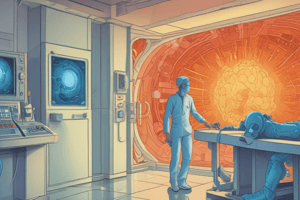Podcast
Questions and Answers
What is the main role of nuclear medicine in cancer diagnosis and treatment?
What is the main role of nuclear medicine in cancer diagnosis and treatment?
To provide valuable insights into tumor growth and behavior through radiotracers and advanced imaging techniques.
How do Positron Emission Tomography (PET) scans contribute to cancer diagnosis?
How do Positron Emission Tomography (PET) scans contribute to cancer diagnosis?
By identifying cancer cells throughout the body.
Explain the role of Single Photon Emission Computed Tomography (SPECT) scans in cancer diagnosis.
Explain the role of Single Photon Emission Computed Tomography (SPECT) scans in cancer diagnosis.
Revealing details about blood flow and other functions in the body.
How can nuclear medicine techniques minimize damage to healthy tissue during cancer treatment?
How can nuclear medicine techniques minimize damage to healthy tissue during cancer treatment?
Why is understanding the molecular basis of cancer important in developing targeted treatments?
Why is understanding the molecular basis of cancer important in developing targeted treatments?
What are the two classifications of tumors based on their behavior?
What are the two classifications of tumors based on their behavior?
Explain the role of proto-oncogenes in normal cellular function and how they can become oncogenes.
Explain the role of proto-oncogenes in normal cellular function and how they can become oncogenes.
What are the types of mutations at the atomic level that can affect genes like proto-oncogenes?
What are the types of mutations at the atomic level that can affect genes like proto-oncogenes?
How do tumor suppressor genes normally prevent cancer development?
How do tumor suppressor genes normally prevent cancer development?
Explain how cancerous tumors can spread to other parts of the body.
Explain how cancerous tumors can spread to other parts of the body.
Study Notes
Nuclear Medicine
Nuclear medicine is a specialized field within medical imaging that involves the use of radioactive materials to diagnose and treat diseases, particularly those involving organs and tissues inside the human body. It has become a vital tool in modern healthcare, contributing significantly to our understanding of various conditions, including cancer, tumors, and their underlying genetic mechanisms.
Cancer and Tumors
Cancer is characterized by the uncontrolled growth of cells in the body due to mutations. These cells can form masses called tumors, which are classified as either benign (non-cancerous) or malignant (cancerous). Cancerous tumors can invade nearby tissue and spread to other parts of the body through blood vessels, lymphatic channels, or direct invasion.
Proto-Oncogenes and Atoms
Proto-oncogenes are normal cellular genes that control cell division and growth, but when they become abnormal due to mutations, they can behave like oncogenes, promoting uncontrolled cell growth. On the atomic level, these mutations involve changes in the DNA sequence, such as single nucleotide polymorphisms (SNPs), insertions, deletions, or rearrangements.
Tumor Suppressor Genes
Tumor suppressor genes normally help prevent cancer development by regulating cell growth and repairing damaged DNA. However, if they malfunction due to mutations, they lose their ability to control cell growth and can contribute to cancer progression.
How Nuclear Medicine Works
In nuclear medicine, doctors use small amounts of radioactive material called radiotracers to create images of the body's internal structures and functions. Radiotracers emit radiation that can be detected outside the body using special cameras and equipment, allowing doctors to visualize the distribution and concentration of specific molecules or chemicals in different areas of the body. This helps them identify diseased or injured areas where activity levels differ from surrounding healthy tissues.
Nuclear medicine techniques are used primarily in oncology, cardiology, neurology, and orthopedics. In cancer diagnosis, they can detect tumors and metastases earlier than traditional methods and monitor the effectiveness of treatment over time. For example, Positron Emission Tomography (PET) scans are commonly used to identify cancer cells throughout the body, while Single Photon Emission Computed Tomography (SPECT) scans can reveal details about blood flow and other functions in the body.
In cancer treatment, nuclear medicine techniques can be used to deliver targeted radiation therapy to cancer cells, minimizing damage to surrounding healthy tissue. This is particularly useful in treating inoperable cancers and reducing treatment-related side effects.
Summary
In summary, nuclear medicine plays a crucial role in cancer diagnosis and treatment, providing valuable insights into tumor growth and behavior through the use of radiotracers and advanced imaging techniques. Understanding the molecular basis of cancer and tumors, including proto-oncogenes, tumor suppressor genes, and their atomic mutations, helps medical professionals develop targeted treatments and improve patient outcomes.
Studying That Suits You
Use AI to generate personalized quizzes and flashcards to suit your learning preferences.
Description
Explore the role of nuclear medicine in diagnosing and treating cancer, using radioactive materials to create images of internal structures and functions. Learn about proto-oncogenes, tumor suppressor genes, and how nuclear medicine techniques like PET and SPECT scans help in early detection and targeted therapy for cancer.




